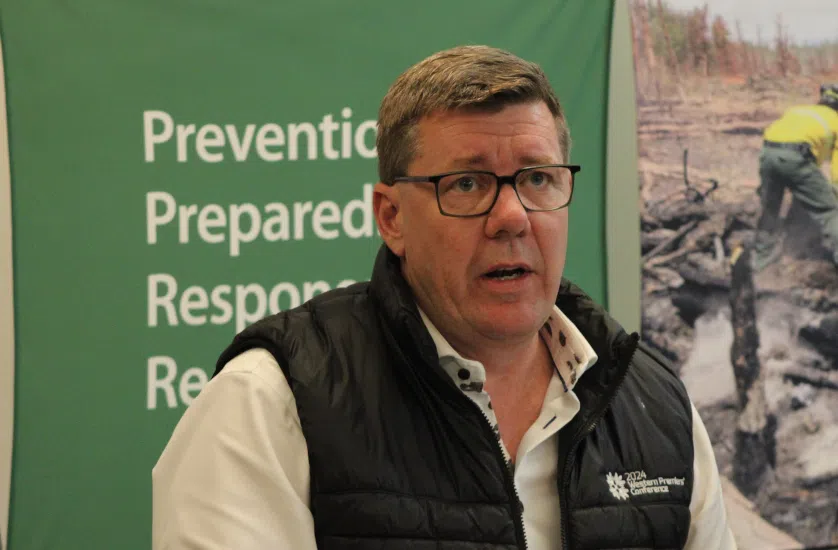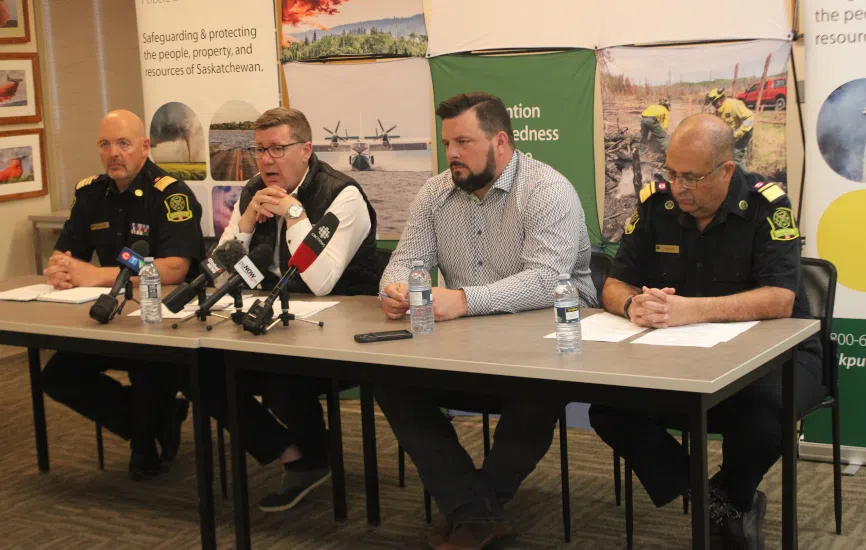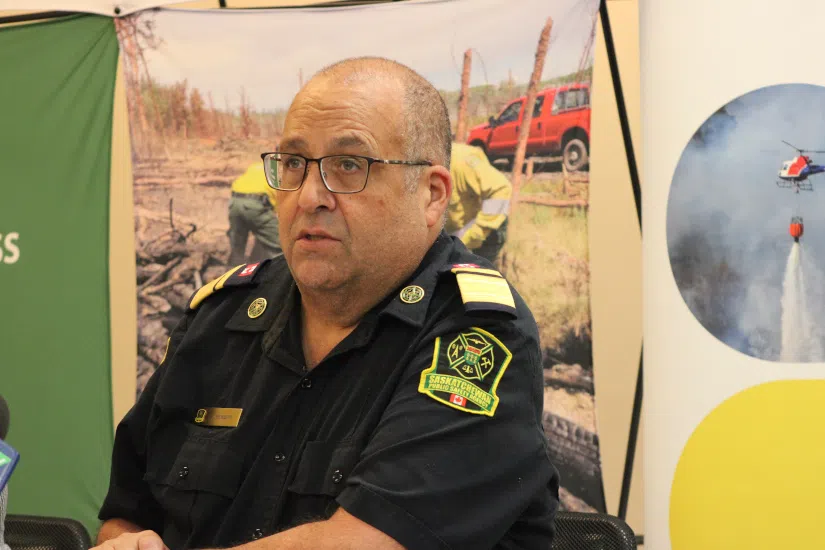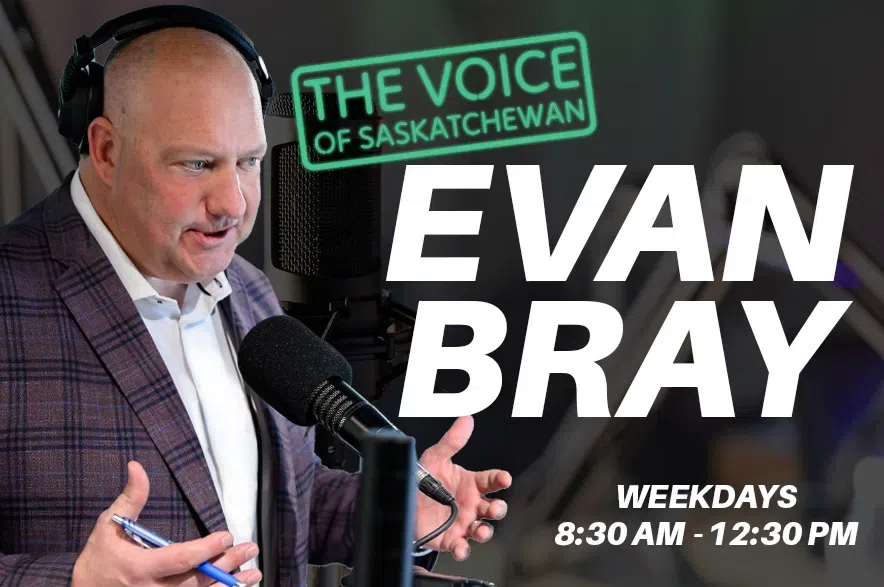By Nigel Maxwell
Due to the wildfires affecting communities across Saskatchewan, Premier Scott Moe, in conjunction with the Saskatchewan Public Safety Agency (SPSA), declared a provincial State of Emergency.
As of Thursday afternoon, there are 17 active wildfires in Saskatchewan and 15 communities have been evacuated. To date this year, there have been 207 wildfires, well above the five-year average of 125. The fires have forced more than 4,000 residents from their homes, mainly in the province’s remote northeast region.
Read More:
- Thursday wildfire update: 4,300 currently evacuated in Sask.
- ‘If a fire gets in here, I don’t know where it stops’: Candle Lake resident
- Winnipeg opens its doors as thousands flee crippling fires in northern Manitoba
“We are seeing the devastating effects of wildfires impact communities across our province,” Moe said. “Therefore, today we are making a Provincial Declaration of Emergency to mobilize the resources necessary to safely evacuate Saskatchewan residents and to protect our communities.”
The declaration provides enhanced powers that may be required to help address an unprecedented start to the fire season. SPSA Vice President Steve Roberts also confirmed additional support from their mutual aid partners, from B.C. to the Maritimes.
“And that includes aviation resources, ground crew resources and fire equipment is being mobilized to come into to province to augment our effort,” Roberts said.
Moe said he has not asked the federal government for assistance but may do so in the days ahead.
Federal Emergency Management Minister Eleanor Olszewski, on social media, said she was monitoring the fires and planned to meet with Saskatchewan Public Safety Minister Tim McLeod.
Roberts also issued a reminder that there is currently a provincial fire ban in place, which means absolutely no open fires and no fireworks.
Effective 5 p.m. Thursday, the SPSA also revised the fire ban to prohibit the use of all-terrain vehicles and utility terrain vehicles on all vacant Crown land, provincial parks located within the provincial forest and the Northern Saskatchewan Administrative District.
“The vast majority of the active fires in the province are caused by human activity,” said Roberts. “By revising the fire ban to prohibit ATVs and UTVs, we are taking a significant step to reducing the number of fire starts.”
The state of emergency will be in effect for 30 days and can be extended if necessary.
Saskatchewan is the second province to invoke a state of emergency.
On Wednesday, Manitoba Premier Wab Kinew made the emergency declaration as fires forced 17,000 people to escape to safety, including all 5,000 residents of the city of Flin Flon.
The SPSA has committed to providing daily updates on the current wildfire situation to ensure that Saskatchewan residents are provided with the most up-to-date information. When asked about the timing of the announcement and public criticism, Moe reiterated that the state of emergency is to help the province prepare for the coming days, where conditions are expected to deteriorate further.
“So it isn’t about the urgency or the timing of declaration of emergency, but it’s about ensuring we have it in place so we have the resources for the wildland fire teams when they need it, but also that supports are in place for potential evacuees from northern Saskatchewan communities,” Moe said.
Response to PAGC State of Emergency
On Wednesday, in response to the rapidly escalating wildfire threat across northern Saskatchewan and the impending evacuation of thousands of people, the Lac La Ronge Indian Band (LLRIB), Peter Ballantyne Cree Nation (PBCN), and Montreal Lake Cree Nation (MLCN) declared a Joint State of Emergency.
The Prince Albert Grand Council (PAGC) is asking for deployment of additional firefighters, including Type 3 personnel, water bombers and air support, fair and equitable distribution of emergency resources to First Nations communities and direct meetings with Premier Scott Moe, federal ministers and MPs. Moe confirmed he has had a number of recent conversations with not only PAGC leadership but also northern Mayors.
“The SPSA is constantly talking at every level, with communities that are being impacted by the Wildland fire, and communities that are in the line of fire and potentially may be evacuated,” he said.

Scott Moe offered his support to all the families impacted by the fires. (Nigel Maxwell/ paNOW Staff)
Referencing an ongoing conversation he’s had with PAGC Grand Chief Brian Hardlotte, Moe said a big talking point was around training, and specifically Type 3 wildland firefighters and having them available for situations like we’re faced with today.
“I believe there’s two additional crews that are working through some of the partnership and the training that is happening with PAGC specifically, and that’s maybe a foundation for us to build on in a post-emergent environment that we are seeing here today,” Moe said.
Drone incident
During Thursday’s press conference, it was revealed there had been one incident involving a drone, which are prohibited in airspace where there are wildfires. SPSA Vice President Steve Roberts noted this was the first documented case they had this year, adding that there have been stories shared by both their U.S. and Canadian partners.
“They have faced similar situations where they have been prevented from responding to fires effectively because of drone activity,” he said.
Roberts went on to explain that the drones effectively prevent their air tankers from entering the airspace.
“If you can imagine an air tanker travelling at treetop level in smoky conditions at 260 knots is not going to see somebody’s drone until it is far too late. It’s too small, doesn’t show up on radar and so they pose an extreme hazard,” he said.
Roberts acknowledged the user may simply have a drone for recreational use, or it could be a member of the media who has in the past asked permission to fly their drone over a wildfire.
“I know people would like to see and know if their cabin is okay and those items, but if it’s going to prevent the operation that’s going to save that cabin, it’s probably counterproductive,” he said.
Military help
Steve Roberts was also asked by the media why military help has not been requested. It’s a measure Manitoba has taken to help with evacuees and one that has been used in the past.
He acknowledged that in 2015, Saskatchewan did have ground forces to support firefighters, and were assigned to fires that were already contained, partially contained and the risk had dropped.
“Military firefighters do not do this as a permanent occupation, so they are never put in the high-risk situations that our trained, experienced people are going to,” he said.
Roberts then went on to explain military personnel essentially serve a similar role as people who have certification and skills that can be added as the fire situation calms, and lines are secured.
“In the current situation in Saskatchewan, there is no spot where we would have large amounts of military individuals, and we currently do not have evacuation situations where the military is required,” he said.













